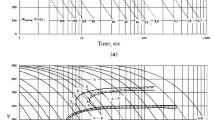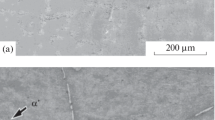Abstract
This work studies the effect of single and double tempering at various temperatures on the mechanical properties of a new corrosion-resistant high-chromium (13% Cr) economically alloyed pipe steel quenched from an intercritical temperature interval. The existence of a maximum of impact toughness and minimum of yield strength at equal temperatures on the dependences of these quantities on the tempering temperature is shown. The temperature of the extrema is supposedly determined by the position of the “nose” of the C‑shaped temperature diagram of the precipitation of (Cr,Fe)23C6 carbide particles from martensite during tempering. It is shown that the position of the extrema does not depend on the duration of the first general tempering.


Similar content being viewed by others
REFERENCES
F. B. Pikering, Physical Metallurgyl and Design of Steels (Metallurgiya, Moscow, 1982) [in Russian].
F. F. Khimushin, Stainless Steels (Metallurgizdat, Moscow, 1969) [in Russian].
D. A. Mirzaev, A. S. Bezik, S. A. Sozykin, and A. N. Makovetskii, “Effect of intercritical quenching on the mechanical properties of the 13Kh11N2B2MF steel,” Vestnik MGTU im. G. I. Nosova, No. 4, 45–49 (2018).
L. N. Belyakov and V. I. Kozlovskii, “Retained austenite in martensitic stainless steels,” Metalloved. Term. Obrab. Met., No. 2, 52–54 (1965).
K. A. Laev, “The effect of alloying and heat treatment on the structure and properties of corrosion-resistant high-chromium steels of martensitic and supermartensitic classes for the manufacture of oil and gas pipes,” Abstract Cand. Diss. (YuURGU, Chelyabinsk, 2016) [in Russian].
I. Yu. Pyshmintsev, S. M. Bityukov, K. A. Laev, A. N. Boryakova, and D. A. Manannikov, “Study of steels of the “super-chromium” class intended for the manufacture of corrosion-resistant high-strength oil pipes,” Chern. Metall., No. 2, 51–56 (2010).
M. A. Smirnov, I. Yu. Pyshmintsev, K. A. Laev, and A. M. Akhmed’yanov, “The effect of high-temperature thermomechanical processing on the properties of high-chromium steel,” Vestn. YuUrGU. Ser. “Metallurgiya”, No. 39, 85–88 (2012).
D. A. Mirzaev, S. A. Sozykin, A. N. Makovetskii, A. O. Krasnotalov, and L. I. Yusupova, “Dilatometric study of the formation of martensite and stabilization effects of austenite in 15Kh13N2 high-chromium steel,” Phys. Met. Metallogr. 120, 770–774 (2019).
T. Nishizawa and A. Chiba, “Phenomenological consideration on interphase equlilibrium in diffusion couple,” J. Jpn. Inst. Met. 34, 629–637 (1970).
G. N. Dubinin, “On the mechanism of diffusion layer formation,” Zashch. Pokryt. Met., No. 10, 12–17 (1976).
L. E. Popova and A. A. Popov, Diagrams of Transformation of Austenite in Steels and Beta-Solutions in Titanium Alloys, Handbook of Heat Treatment Specialist, 3rd ed., (Metallurgiya, Moscow, 1991) [in Russian].
K. A. Lanskaya, High-Chromium Heat-Resistant Steels (Metallurgiya, Moscow, 1976) [in Russian].
M. L. Bernshtein, L. M. Kaputkina, and S. D. Prokoshkin, Tempering of Steel (MISIS, Moscow, 1997) [in Russian].
J. Beech and D. H. Warrington, “M7C3 to M23C6 transformation in chromium containing alloys,” J. Iron Steel Inst. 204, 460–468 (1966).
A. P. Gulyaev, “Carbide transformations in alloy steels,” Met. Sci. Heat Treat. 1, 53–60 (1959).
J. W. Martin and R. D. Doherty, Stability of Microstructure in Metallic Systems (Cambridge University, Cambridge, 1976, 1997; Atomizdat, Moscow, 1978).
I. I. Kositsyna, V. V. Sagaradze, Yu. N. Zuev, and A. Peruha, “Decrease in the ductile–brittle transition temperature of a high-chromium reactor steel MANET-II,” Phys. Met. Metallogr. 86, 205–210 (1998).
Author information
Authors and Affiliations
Corresponding author
Additional information
Translated by E. Chernokozhin
Rights and permissions
About this article
Cite this article
Makovetskii, A.N., Mirzaev, D.A., Yusupova, L.I. et al. Changes in the Mechanical Properties of High-Chromium Economically Alloyed Pipe Steel Depending on Tempering Conditions after Intercritical Quenching. Phys. Metals Metallogr. 121, 398–403 (2020). https://doi.org/10.1134/S0031918X20040080
Received:
Revised:
Accepted:
Published:
Issue Date:
DOI: https://doi.org/10.1134/S0031918X20040080




